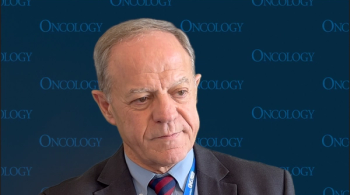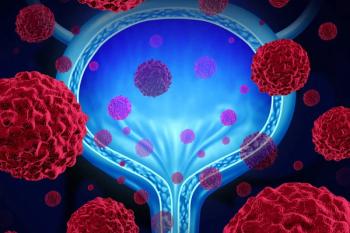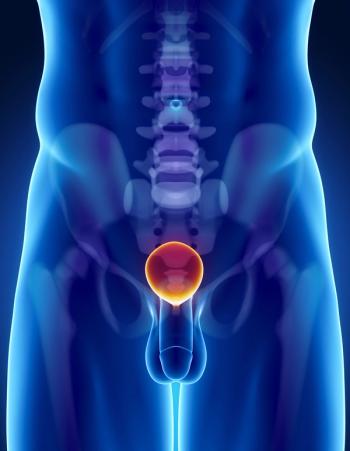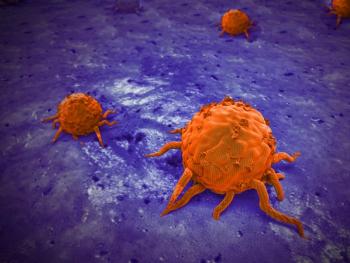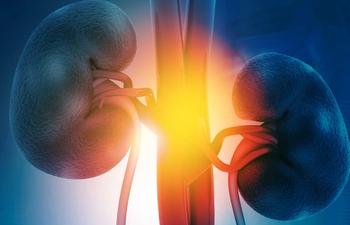
- ONCOLOGY Vol 12 No 4
- Volume 12
- Issue 4
Contemporary Hormonal Management of Advanced Prostate Cancer
The traditional definition of “advanced” prostate cancer includes only patients with widespread osteoblastic or soft-tissue metastases (clinical or pathologic stage T any N any M1; or stage D2). Current evidence indicates that
The review by Dr. Moul in this issue is both timely and relevant to the care of patients with advanced prostate cancer. With prostate-specific antigen (PSA) screening detecting cancer earlier, more patients are being diagnosed with apparently localized disease. Gleason scores and PSA levels help identify those patients who have a high probability of organ confined-disease; however, despite stratification, some patients have more advanced disease than was initially thought.
Poor prognostic factors, such as capsular or seminal vesical invasion, metastatic lymph nodes, or positive surgical margins, can often be uncovered when examining final pathology specimens after radical prostatectomy. Patients presenting with these poor prognostic factors are at high risk for relapse, which is often biochemical and manifested solely by a rising serum PSA.
It is possible to salvage a minority of these patients with further local therapy, either adjuvantly or at the time of rising PSA. Unfortunately, the majority of patients will eventually develop metastatic disease. Thus, the inclusion of these patients by Dr. Moul in the advanced group is warranted, particularly in light of the fact that fewer stage D2 patients are being entered into clinical trials.
We have all faced the distraught patient with a rising PSA who cant sit and wait for things to happen because either his PSA continues to rise, or his urologist or radiation oncologist has told him that he is at high risk for relapse. Unfortunately, only scant or conflicting data are available to guide the physician in the management of such a patient. The most pressing questions for both physicians and patients that need to be incorporated into future trials are summarized below.
Timing of Androgen Therapy
In the United States, serum PSA levels are generally checked every 3 to 4 months after local therapy. Although these values are faithfully monitored by both patient and physician, little information is available regarding when to begin androgen ablation in the patient with a rising PSA. Should treatment be initiated at 0.5 ng/mL or at ? ng/mL?
The results of randomized trials favor the use of early androgen blockade. In patients with locally advanced or metastatic disease, the Medical Research Council (MRC) study indicates that immediate treatment with androgen ablation is associated with fewer cancer-related complications and, in some subgroups, with longer life than in those whose therapy is delayed until they present with symptoms.
Do all patients need to be treated with immediate androgen blockade? Can PSA or other clinical parameters be used to stage these patients? Unfortunately, PSA values for patients entered in the MRC study were not reported. In fact, most did not have bone scans evaluated prior to or during therapy. Therefore, no conclusions can be drawn about a threshold PSA value for androgen ablation. Clearly, randomized trials are needed to address this issue.
Total Androgen Blockade vs Monotherapy vs intermittent Therapy
Conflicting trial results in advanced prostate cancer patients have left many physicians in a quandary about treatment recommendations. The clearest support for the concept of total androgen blockade comes from the National Cancer Institute (NCI) and Southwest Oncology Group trial (SWOG). In this trial, the combination of leuprolide (Lupron) and flutamide (Eulexin) produced a superior overall survival when compared to monotherapy, particularly in patients with minimal disease (as defined by four or fewer bone lesions).[1]
A recent SWOG study demonstrating no survival advantage, even in minimal disease patients, of the combination of orchiectomy and flutamide over orchiectomy alone has forced investigators to rethink that concept.[2] Two meta-analyses, one of 22 randomized combined androgen blockade trials and the other of 9 such trials, produced conflicting results, which only furthers the confusion.[3,4] The majority of patients entered into these randomized trials had bone metastastes, and cannot be directly compared to[AU: PLEASE FINISH THE SENTENCE]
Perhaps the most important trial now accruing patients is SWOGs randomized study comparing continuous, total blockade to intermittent therapy. Both efficacy and quality of life are being analyzed in this group of patients with six or fewer bone lesions. Perhaps this trial will give us some evidence as to whether intermittent therapy in the asymptomatic PSA-relapsed patient is more or less effective than total blockade. A clear definition of the role of combined blockade may emanate from these analyses if sufficient numbers of asymptomatic PSA-relapsed patients are included. [AUTHOR: OK AS EDITED?]
Future Avenues for Study
In addition to the potential trials outlined above, the identification of new drugs and targets will clearly open other avenues for study. Prostate cancer is a heterogeneous disease, consisting of both androgen-dependent and -independent clones. Recent advances in the treatment of patients with hormone-refractory prostate cancer have started to dispel the theory that this is a chemorefractory tumor. Treatment of patients with such regimens as mitoxantrone (Novantrone) combined with prednisone, estramustine (Emcyt)-based combinations, and suramin have resulted in improvements in quality-of-life indices, reductions in cancer-associated bone pain, declines in serum PSA, and regression of measurable lesions. Unfortunately, randomized trials have yet to demonstrate a survival advantage.
Would administering a combination of androgen blockade and cytotoxic agents to patients with a post-prostatectomy asymptomatic PSA rise improve the chances of eradicating the hormone-refractory clones over a similar treatment administered to refractory patients with bone metastases? Is eradication of hormone-refractory[AUTHOR: PLEASE COMPLETE THE QUESTION] Would earlier administration of a combination regimen enable the investigator to increase overall drug dosage with less toxicity to a healthier patient? These questions cannot be answered without randomized trials.
Advances have been made in other tumors, notably in breast cancer, through large-scale adjuvant trials with more than 300,000 men expected to be diagnosed with prostate cancer in the United States in 1997, the patient population is there for study. Now is the time to plant the seeds of well-designed clinical trials. The trees that will grow from these seeds will take years to bear fruit, but will do so only if properly planted in a fertile field.
References:
1. Crawford ED, Eisenberger MA, McLeod DG, et al: A controlled trial of leuprolide with and without flutamide in prostate carcinoma. N Engl J Med 321:419-424, 1989.
2. Eisenberger M, Crawford ED, McLeod D, et al: A comparison of bilateral orchiectomy, with or without flutamide, in stage D2 prostate cancer. Proc Am Soc Clin Oncol 16:2, 1997.
3. Prostate Cancer Trialists Collaborative Group: Maximum androgen blockade in advanced prostate cancer: An overview of 22 randomized trials with 3283 deaths in 5710 patients. Lancet 346:265-269, 1995.
4. Caubet JF, Tosteson TD, Dong EW, et al: Maximum androgen blockade in advanced prostate cancer: A meta-analysis of published, randomized controlled trials using nonsteroidal antiandrogens. Urology 49:71-78, 1997.
Articles in this issue
over 27 years ago
Prevalence of Substance Abuse Disorders in Cancer Patientsover 27 years ago
Public Access to ONS Online Cancer Information Service Now Availableover 27 years ago
Finnish Study Suggests Vitamin E Prevents Prostate Cancerover 27 years ago
Gene Linked to Breast, Ovarian, and Uterine Cancersover 27 years ago
Scientists Shed Light on Anticancer Effects of SoybeansNewsletter
Stay up to date on recent advances in the multidisciplinary approach to cancer.


